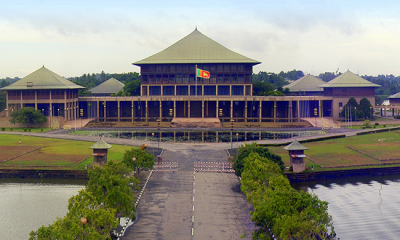News
House in impasse on selecting CC member to fill last remaining vacancy
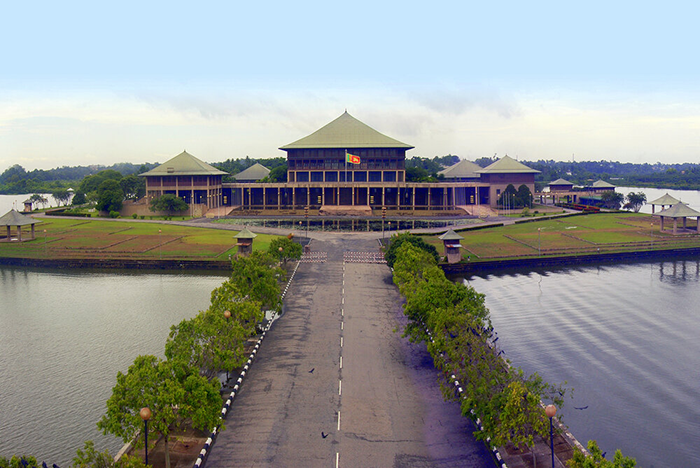
By Shamindra Ferdinando
Political parties are yet to reach a consensus on the appointment of a Constitutional Council member who does not represent the government, or the Samagi Jana Balavegaya (SJB) led Opposition.
Political sources said that since a meeting chaired by Speaker Mahinda Yapa Abeywardena, on Dec. 08, 2022, ended inconclusively, there hadn’t been any effort to fill the vacancy. Sources said that an agreement on the issue at hand was unlikely soon as the Parliament wouldn’t meet again this month.
The CC consists of 10 members. The CC has taken a spate of decisions over the past few months and the latest was the ratification of President Ranil Wickremesinghe’s decision to grant a three month extension to IGP C.D. Wickremaratne.
Responding to The Island queries, sources said that at the Dec 08 meeting the Tamil National Alliance and Uththara Lanka Sabhagaya locked horns over the CC slot allocated for those parties not aligned with the government or the Opposition. The situation remains the same as the Speaker’s Office was yet to make a fresh effort, sources said.
On behalf of the TNA, Jaffna District MP M.A. Sumanthiran has proposed Vanni district lawmaker, Dharmalingam Siddarthan, as the CC nominee, whereas Wimal Weerawansa named Jayantha Samaraweera, in the absence of Udaya Gammanpila, who hadn’t been present at the commencement of the meeting.
However, Gammanpila was subsequently named as their nominee, soon after he walked in. Sources said, those present couldn’t reach a unanimous agreement though the meeting lasted for over an hour at the Committee Room 01.
The Speaker’s Office said that the CC member was to be appointed, in terms of Article 41A (1) (f) of the Constitution. Accordingly, the Speaker’s Office requested MPs, who do not represent the government, and those not affiliated with the SJB, to attend. The Speaker has warned that nominations for the said appointment wouldn’t be accepted from those not present at the meeting.
The TNA has pressed for the slot on the basis of none of the six out of seven CC members, so far appointed in ex officio capacity, or nominated, included a Tamil speaking lawmaker.
However, the rebel SLPP group has declared that Uththara Lanka Sabhagaya, as well as other breakaway factions, should have the right to be represented as they no longer functioned as part of the ruling party.
In addition to Prime Minister Dinesh Gunawardena, Opposition Leader Sajith Premadasa, and Speaker Abeywardena, who are ex-officio members, the SLPP parliamentary group, the President and the Opposition Leader named Sagara Kariyawasam, Nimal Siripala de Silva and Kabir Hashim to function as CC members, respectively. Three civil society members, too, have been named.
Sources pointed out that the proposal to name Jayantha Samaraweera/Udaya Gammanpila as their nominee has been seconded by Anura Priyadarshana Yapa, another rebel, though not being a member of Uththara Lanka Sabhagaya.
The other SLPP rebel group Nidahas Jathika Sabhawa has refrained from backing their colleagues’ move, sources said.
Sources said that Yuthukama leader Gevindu Cumaratunga has pointed out that since Sumanthiran worked closely with President Wickremesinghe, the President’s Counsel should have been considered the President’s nominee, instead of SLFPer Nimal Siripala de Silva.
Cumaratunga also questioned the appointment of SLPP General Secretary Sagara Kariyawasam as the SLPP’s nominee, as he didn’t vote for the 21st Amendment that paved the way for the 10-member CC. MP Kariyawasam was among nearly 40 ruling party members who abstained at the vote on 21 Amendment.
MP Sudarshini Fernandopulle, leader of the Women Caucus in Parliament, has pointed out the failure on the part of her colleagues to at least to nominate one woman MP.
At one point MP Sumanthiran declared that they would walk out of the Dec 8 meeting. SLPP rebels found fault with the Speaker for not calling for a vote to pick the CC nominee.
Sources said that SLPP rebels, prior to the meeting, sought clarification from the Secretary General of Parliament, Dhammika Dasanayake, whether they could attend the meeting.
Latest News
Landslide RED warnings continue to be in force for the Districts of Kandy, Kegalle, Kurunegala, Matale and Nuwara Eliya
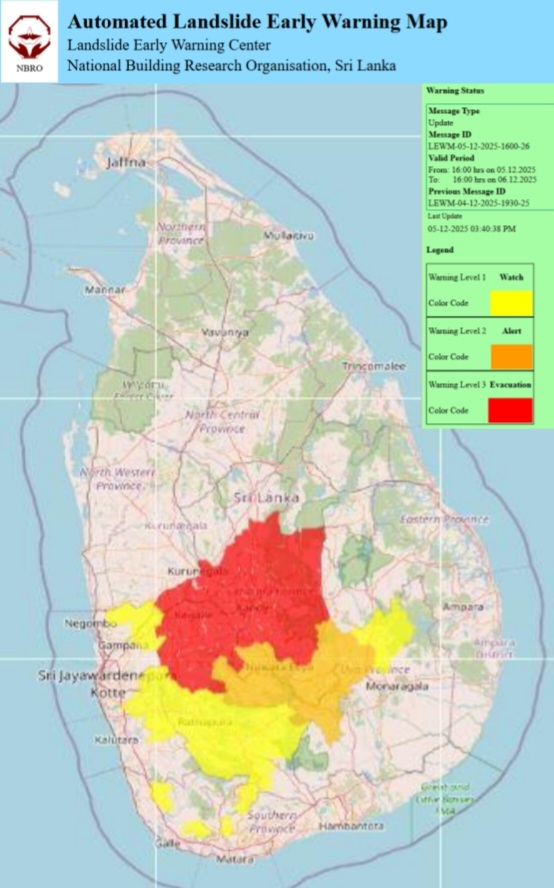
The RED Landslide Early Warnings issued by the Landslide Early Warning Center of the National Building Research Organization [NBRO] to the Districts of Kandy, Kegalle, Kurunegala, Matale and Nuwara Eliya have been extended until 1600hrs today [06th December 2025]. Landslide Early warnings have also been issued to the districts of Badulla, Colombo, Galle, Gampaha, Kalutara, Matara, Monaragala and Ratnapura,
Accordingly,
LEVEL III RED warnings have been issued to the Divisional Secretaries Divisions and surrounding areas of Gangawata Korale, Deltota, Doluwa, Thumpane, Medadumbara, Minipe, Pathahewaheta, Yatinuwara, Ganga Ihala Korale, Akurana, Udunuwara, Panvila, Pathadumbara, Kundasale, Pasbage Korale, Hatharaliyadda, Ududumbara, Poojapitiya, Harispattuwa and Udapalatha in the Kandy district, Galigamuwa, Kegalle, Mawanella, Rambukkana, Dehiowita, Warakapola, Deraniyagala, Bulathkohupitiya, Ruwanwella, Yatiyanthota and Aranayaka in the Kegalle district, Narammala, Mawathagama, Mallawapitiya, Alawwa, Rideegama and Polgahawela in the Kurunegala district, Rattota, Wilgamuwa, Ukuwela, Pallepola, Matale, Laggala Pallegama, Yatawatta, Naula and Ambanganga Korale in the Matale district, and Nildandahinna, Walapane, Hanguranketha and Mathurata in the Nuwara Eliya district.
LEVEL II AMBER warnings have been issued to the Divisional Secretaries Divisions and surrounding areas of Uva Paranagama, Kandeketiya, Bandarawela, Soranathota, Hali_Ela, Meegahakivula, Badulla, Ella, Haputhale, Lunugala, Welimada, Passara and Haldummulla in the Badulla district, Nuwara Eliya, Ambagamuwa Korale, Thalawakele, Norwood, Kothmale West and Kothmale East in the Nuwara Eliya district, and Kahawaththa, Godakawela and Kolonna in the Ratnapura district.
LEVEL I YELLOW warnings have been issued to the Divisional Secretaries Divisions and surrounding areas of Padukka and Seethawaka in the Colombo district, Elpitiya and Yakkalamulla in the Galle district, Mirigama, Attanagalla and Divulapitiya in the Gampaha district, Bulathsinhala, Ingiriya and Horana in the Kalutara district, Athuraliya and Pasgoda in the Matara district, Bibile and Medagama in the Monaragala district, and Kiriella, Nivithigala, Eheliyagoda, Kuruwita, Kalawana, Pelmadulla, Elapatha, Balangoda, Openayake, Imbulpe, Ayagama, Ratnapura and Kaltota in the Ratnapura district.
News
IMF pledges additional aid to Lanka following Cyclone Ditwah destruction

The International Monetary Fund (IMF), on Thursday, signalled strong solidarity with Sri Lanka in the wake of Cyclone Ditwah, confirming that it is actively exploring options to provide further support for recovery and resilience beyond the existing Extended Fund Facility (EFF).
Julie Kozack, Director of the IMF’s Communications Department, opened her remarks with heartfelt condolences:
“Our deepest sympathies go out to the people of Sri Lanka for the effects of the devastating cyclone. Our hearts mourn the loss of life that has taken place,” she said, extending condolences to other Asian nations also grappling with severe flooding, including Indonesia, Malaysia, Thailand, and Vietnam.
On Sri Lanka, Kozack emphasised that the IMF is closely engaging with authorities, development partners, and counterparts to assess the humanitarian, social, and economic toll of the disaster.
“Large parts of Sri Lanka have been affected by floods, and we expect economic activity to be adversely impacted, in addition to the significant human toll,” she noted.
The IMF is awaiting the completion of a rapid post-disaster damage assessment, led by Sri Lankan authorities, in collaboration with international partners, to better gauge the economic impact.
“We are continuing to support Sri Lanka’s recovery, reform, and resilience under the EFF arrangement. Our staff is looking into options to further support Sri Lanka in the recovery process,” Kozack confirmed.
She reiterated that the Board meeting, scheduled for 15 December, remains on track, following the staff-level agreement on the fifth review reached in October—prior to the cyclone.
“We will provide additional details as the assessment of economic needs and damages moves forward, and as we have more information to inform our thinking around the options,” she added.
News
Marrikkar Mohamed Thahir takes oath as SJB National List MP
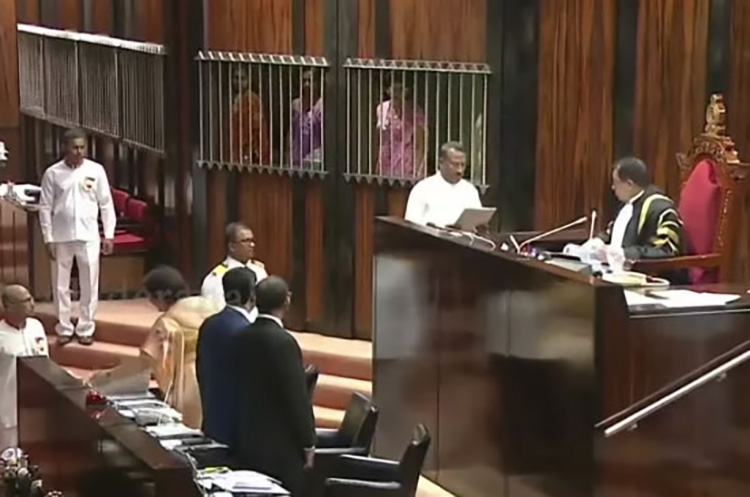
Naina Thambi Marikkar Mohamed Thahir was sworn in as a Samagi Jana Balawegaya (SJB) National List Member of Parliament before Speaker Dr. Jagath Wickramaratne yesterday (05).
His appointment follows the resignation of SJB Parliamentarian Muhammathu Ismail Muththu Mohamed, who stepped down from his position on 28 November.
The SJB subsequently nominated Thahir to fill the resulting vacancy.
Accordingly, the Election Commission issued a Gazette Extraordinary declaring Naina Thambi Marikkar Mohamed Thahir a Member of Parliament, in terms of Section 64(5) of the Parliamentary Elections Act, No. 1 of 1981, as amended by Section 6 of the Elections (Special Provisions) Act, No. 35 of 1988.
With the issuance of the gazette, and the subsequent swearing-in, Thahir has officially assumed duties as a National List MP, representing the SJB.
-
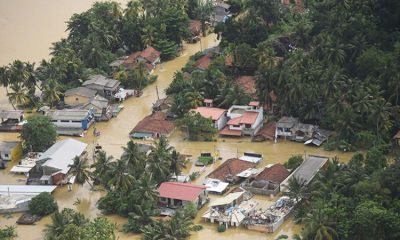
 News6 days ago
News6 days agoWeather disasters: Sri Lanka flooded by policy blunders, weak enforcement and environmental crime – Climate Expert
-
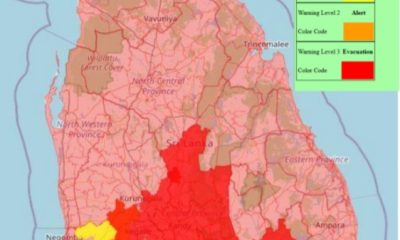
 Latest News7 days ago
Latest News7 days agoLevel I landslide RED warnings issued to the districts of Badulla, Colombo, Gampaha, Kalutara, Kandy, Kegalle, Kurnegala, Natale, Monaragala, Nuwara Eliya and Ratnapura
-
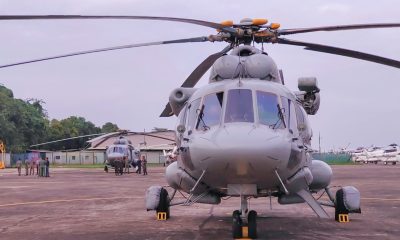
 Latest News7 days ago
Latest News7 days agoINS VIKRANT deploys helicopters for disaster relief operations
-
News3 days ago
Lunuwila tragedy not caused by those videoing Bell 212: SLAF
-
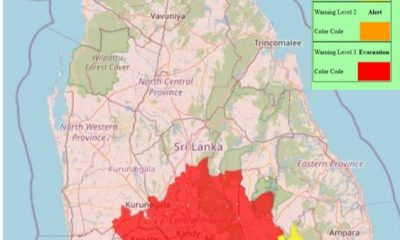
 Latest News4 days ago
Latest News4 days agoLevel III landslide early warnings issued to the districts of Badulla, Kandy, Kegalle, Kurunegala, Matale and Nuwara-Eliya
-
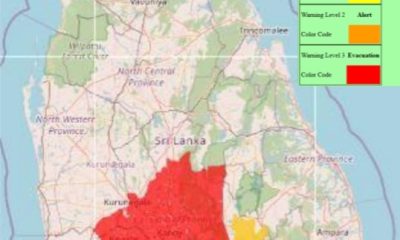
 News2 days ago
News2 days agoLevel III landslide early warning continue to be in force in the districts of Kandy, Kegalle, Kurunegala and Matale
-

 Features4 days ago
Features4 days agoDitwah: An unusual cyclone
-

 Latest News5 days ago
Latest News5 days agoUpdated Payment Instructions for Disaster Relief Contributions


